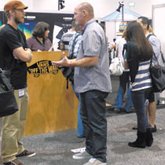Search for Value at ASR
SAN DIEGO—The Action Sports Retailer Trade Expo at the San Diego Convention Center continued its evolution this season, greeting buyers and exhibitors with earlier dates and an expanded roster of affiliated shows.
Exhibitors reported a quiet but successful show with key retailers shopping for Spring 2011 as well as for immediate goods.
Held Aug. 13–15, ASR was joined for a third season by Class@ASR, which focused on high-end swimwear, streetwear, and fashion-forward and crossover action-sports brands; Crossroads, the regional skate-focused trade show that partnered with ASR last season; and Sacred Craft, a consumer surfboard expo held Aug. 14–15.
Andy Tompkins, vice president of Nielsen Sports Group, which produces ASR, said attendance was on par with last year, but he said the Friday-through-Sunday dates in mid-August may have contributed to some buyers not attending the show.
ASR, which traditionally takes place in September after Labor Day, moved its dates up to give buyers an earlier peek at Spring goods and manufacturers a chance to gauge reactions before going into production. Some core retailers said the new dates fell during their busy season, making it hard for them to leave their shops or bring as many staff members as they would like to shop the show.
“There is an adjustment period,” Tompkins said. “Next year, we think, the earlier August dates, paired with a Thursday-through-Saturday run, will help attendance.” ASR will run Aug. 18–20 in 2011.
The show floor got a morale boost thanks to the return of a handful of major players—including Reef, Rip Curl, Roxy and Quiksilver—which sat out ASR in February.Taming costs
Exhibitors and retailers alike approached the show with value in mind.
The majority of brands opted for money-saving, turn-key options offered by show organizers and operated with lean staffs. Product offerings also reflected an emphasis on specialty, value and fashion.
O’Neill launched its Kings of Freak core collection, which is targeted at the core men’s surf/skate market. Heavy on fashion and novelty, the line can be a bit pricier than its standard O’Neill connection in some categories, but it won’t be sold in majors.
Kings of Freak includes boardshorts, walkshorts, wovens, knits, tanks, T-shirts and some accessories. The brand also looked for ways to capitalize on its team riders and seasonal trends. For Spring 2011, O’Neill introduced a capsule collection inspired by the personal style of team rider Jordy Smith. A full Jordy Smith collection will debut for Fall 2010. Ryan Rush, O’Neill’s head of design, said the brand is responding more quickly to up-and-coming trends. Chief among them are shorter inseams on men’s walkshorts. “They’re getting shorter and slimmer and going above the knee,” he said. O’Neill hopped on the trend for Spring 2011, introducing slim shorts in 19-, 21- and 22-inch inseams. “They will drive our walkshort business,” he said.
Another winner that O’Neill wants to capitalize on are woven shirts. “They’re our fourth-largest category,” Rush said. Starting with Spring 2011, O’Neill will sell long-sleeve shirts year-round.New ideas and styles
Quiksilver Women showed a new design direction at Class@ASR. The brand, which is still being touted as a contemporary collection, has moved away from some of the more fashion-forward styles and pricier fabrications that it featured in past seasons.
Now packed with more cotton garments and fewer silk pieces, the collection lost some of its downtown-girl vibe of past seasons in favor of a coastal-lifestyle feel. Wholesale price points now hover around $48 for woven shirts and simple mini-dresses to $78 for slouchy plaid shirtdresses.
Element and Element Eden, labels owned by Billabong, showed a new collection of premium T-shirts in basic and fashion silhouettes for men and women. The shirts, which will retail in the neighborhood of $30 and wholesale for $15 to $18, are crisp and logo-free—something that the brand hopes will appeal to sophisticated shoppers looking for a deal on fashion basics. The brand introduced lightweight jackets for the first time for a Spring delivery based on the success of Fall’s outerwear.
Vans, originally a shoe line now owned by VF Corp., sees potential for growth in its apparel business, said Adriana Matthews, who manages public relations for the menswear line. “We’re gaining momentum and an identity that is separate from the Vans footwear,” she said.
New for Spring 2011 is an “Era Series” line of boardshorts. Named after the classic sneaker style, the collection has design details that reference the shoes, including a lace-up fly reminiscent of sneaker laces and the classic Vans heel tab. Also new is a line of core classic T-shirts that give retailers a new entry-level price into the brand’s T-shirts.
Some brands contracted their offerings for Spring 2011. At Class@ASR, Lightning Bolt showed a collection that did not include womenswear. The heritage line instead will focus on menswear, where it can make the most of the nostalgia associated with the brand.
Lira, a Chino, Calif.–based lifestyle brand that always touted its surf and skate roots, debuted its first collection of boardshorts at Class@ASR. “It was about time. There is a ton of potential in swimwear,” said Todd Kellogg, the brand’s founder.
Rusty, which last season debuted its Wired Series of hoodies loaded with built-in earbuds, expanded the collection for men and women for Spring 2011. Moving beyond hoodies, the Wired Series was incorporated into Rusty’s first-ever activewear line as well as separates. Dresses, windbreakers, hooded woven shirts and cotton-blend mini-dresses are all equipped with Rusty’s built-in, machine-washable headphones.
“We all have to work on margins,” said Coco Tihanyi, co-owner of the Surf Diva shop and surf school in La Jolla, Calif. Tihanyi, who hasn’t finalized her Spring budget but said strong sales in certain categories could push it to grow, said core shops competing with majors are having a hard time. “Majors are constantly offering deals and sales and gift-with-purchase,” she said.
To compete, many core retailers shop for brands with tighter distribution and push manufacturers for deals on some items. “[Brands] are definitely making an effort to offer [core shops] special pricing on certain items,” she said.























